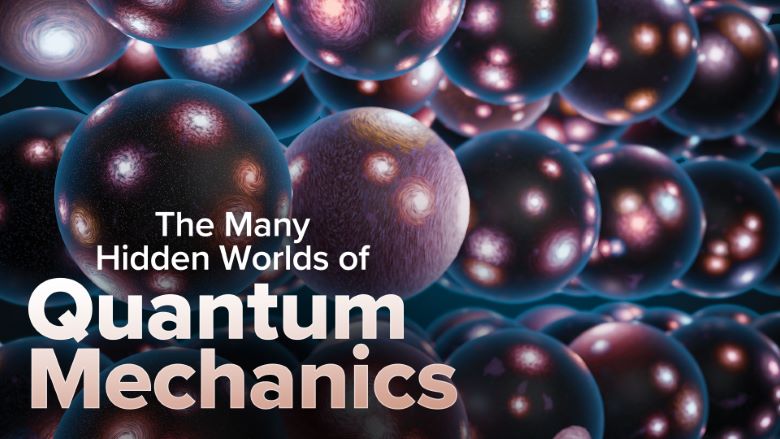Modern physics is filled with ideas that defy common sense, but, nonetheless, have a strong claim to be true. A prime example is Einstein’s twin paradox, about identical twins who age at markedly different rates if one takes a trip at near-light speed. Another is Erwin Schrödinger’s thought experiment involving a cat that is arguably both dead and alive due to a fundamental feature of quantum mechanics.
But no theory strains credulity like “Many-Worlds,” the proposal that we experience only one branch of possibly infinite realities, which sprout like the limbs on a tree, splitting into numberless parallel universes—all of which are equally real. Officially called the Many-Worlds Interpretation (MWI) of quantum mechanics, this seemingly absurd idea may be what’s really going on in our multiverse.
In The Many Hidden Worlds of Quantum Mechanics, noted theoretical physicist, philosopher, and popular author, Professor Sean Carroll of Johns Hopkins University makes an eloquent case that Many-Worlds is the framework that best explains quantum mechanics, which is the science of matter and energy at the atomic and subatomic scales. In 24 accessible and fascinating lectures, he guides you through the history, reasoning, and implications of this bold conjecture. Professor Carroll also covers alternate theories to Many-Worlds and unresolved questions in fundamental physics, making this course a fascinating window into the current state of this exciting field.
Not as Bizarre as It Sounds
How off-the-wall is Many-Worlds? Consider these consequences of the theory:
- Multiverse: Innumerable universes exist simultaneously, and the number is growing exponentially. These universes don’t have a location in space, but space exists inside each, just as in our own universe.
- No Contact: There is no way to travel to these other universes, nor can any signals pass between them. They are isolated and unknowable—yet the simplest version of quantum theory predicts that they exist.
- Duplicates: Countless versions of you exist in these parallel universes. At least, they are you in the sense that each of you shares the same past. However, each version of you is a different person who will experience a unique future.
These claims may sound like science fiction, but there are good reasons to believe them. The Many Hidden Worlds of Quantum Mechanics takes you step by step through the observations, arguments, and counter arguments that first built quantum theory, and then led a group of thinkers inexorably to the Many-Worlds hypothesis. Many-Worlds is by no means the conventional interpretation of quantum mechanics. But as Professor Carroll shows, the extra worlds almost miraculously emerge from the standard equation—whether anyone wants them to or not.
The Birth of Many-Worlds
Many-Worlds is a response to the “Copenhagen Interpretation” of quantum mechanics, named for the city where its principal exponent, Niels Bohr, had his famous research lab in the early 20th century. Designed to account for the strange phenomena observed at the quantum scale, the Copenhagen Interpretation holds that quantum systems are described by a wave function that includes multiple states at the same time. This wave function is governed by the Schrödinger equation until the system is observed. Upon measurement, the system assumes a definite state, an event that Bohr and his colleagues termed the “wave function collapse.” According to the Copenhagen Interpretation, the wave function is a mathematical tool used to predict the probability of measurement outcomes, rather than a direct representation of reality.
In the 1950s, physicist Hugh Everett objected that the wave function collapse was an ad hoc addition to the mathematically elegant Schrödinger equation. Instead, he proposed that the collapse is only apparent, and that we should stick to what the equation tells us: that all possible outcomes continue to evolve in parallel, leading to a branching structure of many non-interacting universes.
Mysteries Solved?
The beauty of Many-Worlds is that it resolves several long-standing paradoxes that have given quantum mechanics its reputation as a theory that not even physicists fully understand. Among these are:
- “Spooky Action at a Distance”: This was Einstein’s term for quantum interactions that appear to take place faster than the speed of light, due to the instantaneous collapse of the wave function.
- Schrödinger’s Cat: This thought experiment describes the puzzling state of a cat before the collapse of a wave function that will decide whether it is alive or dead due to the random release of poison.
- The Observer Problem: In the Copenhagen Interpretation, the mere act of observing instantly collapses the wave function, making a macroscopic world of human thought and action a decisive part of a quantum system.
In each example, Many-Worlds sidesteps these problems by postulating that all possible outcomes take place in separate realities. In the case of “spooky action at a distance,” the consequences of the quantum interaction appear in different universes; therefore, no signal can pass between them, and no faster-than-light travel is involved. For Schrödinger’s cat, it is alive in one universe and deceased in another. And in the observer problem, there is no special role for observers since all outcomes occur.
Physics Has Surprised Us Before
Not surprisingly, many scientists are unsettled by the Many-Worlds approach and have come up with rival theories that deal with the problems of the Copenhagen Interpretation without invoking multiple realities. Professor Carroll introduces a number of these proposals, discussing their strengths while noting that none is as mathematically simple as Many-Worlds. They include:
- Hidden Variables: Pioneered by French physicist Louis de Broglie and American physicist David Bohm, this class of theories adds new variables in addition to the wave function to make it deterministic and to remove the mystery of the Copenhagen model.
- GRW: Ghirardi–Rimini–Weber theory (GRW) endorses the reality of the wave function collapse but makes it spontaneous and random rather than due to the act of measurement. It involves modifying the usual equation obeyed by the wave function.
- QBism: Standing for Quantum Bayesianism, this view uses Bayesian reasoning to make probabilistic predictions about quantum experiments. Its proponents criticize other approaches for objectifying the quantum state, which QBism does not.
And looming over all the lectures is classical physics, the project energized by Isaac Newton in the 17th century, and which reached an unexpected hurdle at the beginning of the 20th century, to be supplanted by quantum theory. The Copenhagen Interpretation then reigned as the most influential view of quantum phenomena for many decades. Its critics have responded with counter proposals, seeking a breakthrough idea to explain the baffling quantum world.
The Many Hidden Worlds of Quantum Mechanics focuses on one of the most spectacular of these proposals. Professor Carroll is at pains to be open-minded, questioning, and skeptical, while marshalling powerful arguments that Many-Worlds—a theory that almost defies belief —should be believed. It wouldn’t be the first time that physics has surprised us.
01 - Why Suppose Theres More Than One World
02 - The Classical Physics World That Never Was
03 - Quantum Worlds Start with Waves and Particles
04 - A Wave Function to Describe Particles
05 - Copenhagen Says the Wave Function Collapses
06 - Is the Wave Function Real
07 - Uncertainty in Action with Spin and Qubits
08 - Quantum Entanglement and Action at a Distance
09 - Entanglement Leads to Many Worlds
10 - Decoherence Explains Branching Worlds
11 - How Entanglement Powers Quantum Computers
12 - Too Many Worlds! Five Objections Answered
13 - Testing the Many-Worlds Interpretation
14 - Where Does Probability Come From
15 - Quashing Worlds with Wave Function Collapse
16 - Blocking Worlds with Hidden Wave Variables
17 - Mind before Matter in Quantum Theory
18 - The Quantum Emergence of the World We See
19 - The Challenge of Quantum Gravity
20 - Space Emerges from Entanglement
21 - The Quantum Emergence of Time
22 - Free Will, Determinism, and Many-Worlds
23 - What Happens to Ethics under Many-Worlds
24 - A Future Renaissance for Quantum Mechanics
Trailer



